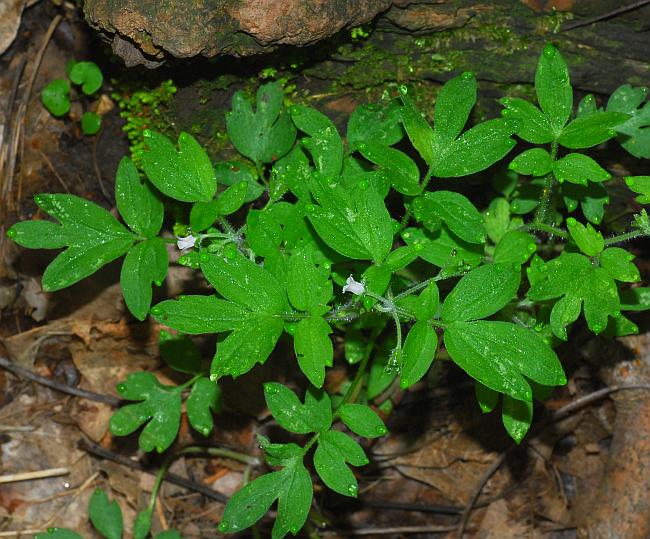Phacelia ranunculacea (Nutt.) Constance
Phacelia

Native
CC = 6
CW = -3
MOC = 8
© SRTurner
Phacelia ranunculacea (Nutt.) ConstancePhacelia | |
 |
Native CC = 6 CW = -3 MOC = 8 |
© SRTurner |
|
Family - Hydrophyllaceae Habit - Taprooted annual forb. Stems - Loosely ascending, to 25 cm, usually branched, moderately pubescent with stiff, spreading, nonglandular hairs toward the base, these grading into dense, fine, glandular hairs well below the midpoint.
Leaves - Basal and alternate. Basal leaves often persistent at flowering, the blade 1-3 cm long, broadly ovate in outline, pinnately compound, these unlobed or moderately to deeply 2- or 3-lobed and sometimes also with a few additional teeth or smaller lobes, the surfaces pubescent with appressed, stiff hairs. Stem leaves all petiolate, the blade 1-4 cm long, progressively less divided toward the stem tip, the uppermost leaf blades often irregularly 3-lobed, the pubescence similar to that of the basal leaves, the petiole often with some glandular hairs.
Inflorescences - Open racemes with 2-6 flowers, the axes and flower stalks densely pubescent with glandular hairs, the stalks pendent at fruiting.
Flowers - Calyces 3-7 mm long, the lobes pubescent with mostly nonglandular hairs. Corollas 2-4 mm long, nearly cylindrical, white or pale lavender to bluish-tinged, the margins entire, the outer surface glabrous. Stamens not exserted, the filaments glabrous. Ovary with 4 ovules. Style branched to about the midpoint.
Fruit - Fruits 4-6 mm long, the surface usually irregularly swollen (distended by the seeds), 2-4-seeded. Seeds 1.8-2.5 mm long, broadly ovoid-angled to nearly globose, finely ridged, light brown to brown.
Flowering - April - May. Habitat - Bottomland forests, ravines, bases of bluffs, gardens. Origin - Native to the U.S. Lookalikes - P. covillei. Other info. - This delicate species is uncommon in Missouri, and found here only in the bootheel region. Its natural range includes only that region and small portions of neighboring states. It is difficult to distinguish from the closely related P. covillei, a species which is rare across its range and seldom encountered. Photographs taken at Mingo National Wildlife Refuge, Stoddard County, MO, 4-17-2015 (SRTurner). |